
Home About Us Contact Us Subscribe

Home About Us Contact Us Subscribe
|
|
|
|
Ruins Reclaimed: Scott and Montgomery Halls at San Francisco Theological Seminary by Architectural Resources Group
San Anselmo, California: Thoughtful planning and seismic engineering save two historically significant (and all but abandoned) buildings that have renewed campus spirit - and increased enrollment. by ArchNewsNow April 8, 2002 This is a story about how historic preservation helped save an
institution and restore a great sense of community pride. High on a hill in the
small Marin County town of San Anselmo, California, stood empty stone buildings
that looked like haunted castles. These vacated, eerie “Richardsonian
Romanesque” buildings, dating from the 1890s (among the oldest buildings in the
area) belong to the San Francisco Theological Seminary. Montgomery Hall had
historically been used as the campus dormitory, and Scott Hall housed a library
and classrooms. During the 1960s, the Montgomery Hall dormitory was converted
to faculty offices and occupied until the 1989 Loma Prieta earthquake. Scott
Hall, however, had been vacant for decades. After the earthquake, and until the spring of 1997, the
buildings remained abandoned and in disrepair. Leaking roofs and walls had
caused major water damage. The exteriors suffered from plant overgrowth and
fungus (including mushrooms) on the walls. There were voids and cracks in the
masonry, and the mortar was improperly installed over the course of numerous
building campaigns. Although in a state of disrepair, the buildings contained
historically significant interior spaces and finishes, most notably the two-story,
domed library space in Scott Hall. In the mid-90s, the Seminary undertook a comprehensive
campus master plan to address current programming needs. The master plan team,
including San Francisco-based Architectural Resources Group (ARG) and Degenkolb
Engineers, found that the campus lacked conference space and classrooms, and
that the administrative offices were scattered. Surveys also revealed that
students felt the campus had no core, no central gathering place, and no strong
sense of community. Initially, rehabilitating Montgomery and Scott Halls was not
considered because it was assumed that the cost would be too high for the small
seminary. But the ARG/Degenkolb feasibility study developed a creative and
efficient seismic strengthening scheme, along with plans to upgrade the
buildings to meet space planning and accessibility requirements. The new plan
returned a 60s era office building to its original conference use, centralized
the administrative offices in Montgomery Hall, and reused Scott Hall’s dramatic
library as a student center with classroom and seminar spaces – a “core” for
student life on campus. Seismic Strengthening
Both buildings were seismically upgraded at a moderate cost
with concrete shear walls, collectors, and floor-to-wall ties. Additionally,
the two-story domed space in Scott Hall included steel bracing within the roof
that was concealed in the mezzanine ceiling to maintain the original central
plaster dome. Where floor-to-wall ties were required to be through-wall anchors,
ARG designed a 6-inch-diameter cover plate. Exterior Rehabilitation
For the stone walls, an extensive exterior survey determined
the source of water infiltration, and test panels were prepared to finalize the
rehabilitation method. The solution included complete repointing, cleaning,
stone repair, and limited stone replacement. The roofs, which had leaked since
shortly after the original construction, were replaced with new slate and
copper flashing. Interior Rehabilitation
The interior design included programmatic changes to the
historic spaces to create modern classrooms, meeting rooms, offices, and the
student center. The State Historic Building Code was employed to retain
existing finishes and features while providing improved life safety features.
ADA accessibility was accomplished by installing elevators in both buildings;
in Scott Hall, an existing first floor window was replaced with a door,
creating an accessible second entry. The programming issues were solved and costs were far less than expected.
Alumni rallied around the restoration, and the necessary funds were raised very
quickly. By combining thoughtful planning and ingenious seismic engineering,
the historically significant buildings were saved and, today, give the campus a
center and identity. Recent promotional literature features the restored
buildings. Since reopening the two halls, there is a renewed spirit at the San
Francisco Theological Seminary – and increased enrollment. In this era, that
translates into survival. Also, many of the townspeople now hike around the
grounds; the reclamation of Scott and Montgomery Halls has created a very
positive public response and restored a great sense of community pride. The project received a Preservation Design Award from the
California Preservation Foundation. Owner: San Francisco
Theological Seminary, San Anselmo, CA Architect: Architectural
Resources Group, San Francisco, CA Landscaping: Studio Green,
Mill Valley, CA Structural Engineer:
Degenkolb, San Francisco, CA Mechanical Engineer: William
Mah Mechanical Engineers, San Francisco, CA Electrical Engineer: Pete O.
Lapid & Associates, San Francisco, CA Acoustical Engineer: Shen,
Milsom Wilke/Paoletti, San Francisco, CA Contractor: Plant
Construction Project Management: Hixson
and Associates, Mill Valley, CA Cost Estimator: PH Waszink
Construction Consultant, Sausalito, CA Photography: David Wakely
Photography Architectural
Resources Group, Architects, Planners & Conservators, Inc. is a San
Francisco-based architecture and historic preservation firm founded in 1980.
The firm had been responsible for the adaptive reuse and seismic strengthening
of existing structures, the documentation and restoration of historic
properties, and the design of new structures that fit into historic
surroundings. Well known projects include the Conservatory of Flowers in San
Francisco's Golden Gate Park, the Filoli Estate and Visitor's Center in
Woodside, and the Language Center at Stanford University. |
(click on pictures to enlarge) 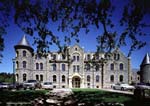 (Photo: David Wakely Photography) Montgomery Hall, primary façade.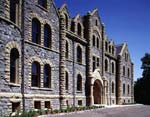 (Photo: David Wakely Photography) Montgomery Hall, detail of primary façade.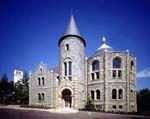 (Photo: David Wakely Photography) Scott Hall, exterior.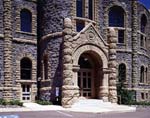 (Photo: David Wakely Photography) Scott Hall entrance; new ADA access is to the left of the main entry.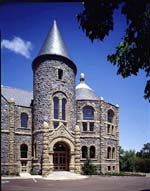 (Photo: David Wakely Photography) Scott Hall exterior.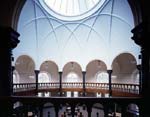 (Photo: David Wakely Photography) Scott Hall Student Center (former library).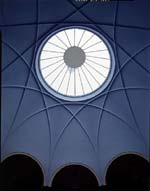 (Photo: David Wakely Photography) Scott Hall with old library dome and skylight restored.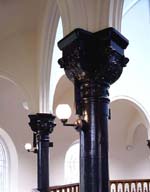 (Photo: David Wakely Photography) Capitals in old library with new brackets for seismic bracing.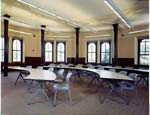 (Photo: David Wakely Photography) New classroom in Scott Hall, below old library space.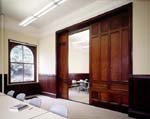 (Photo: David Wakely Photography) Connecting classrooms in Scott Hall, with restored wood doors.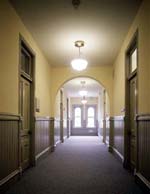 (Photo: David Wakely Photography) Montgomery Hall, interior hallway. |
© 2002 ArchNewsNow.com